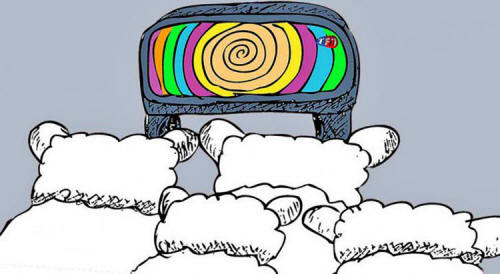|
by Andrew Martin
excerpts taken from 'Rethink…
Your world, Your future' from Collective-Evolution Website
The latest Bond movie, Spectre, touches on an insidious connection between certain vested interests who wish to control intelligence and spy on citizens on a global level.
The movie shows how special interest groups create terror throughout countries in an effort to push through and scare the public and governments into enacting stricter surveillance and reducing civil liberties. While the Bond movie makes the baddies out to be nothing more than a bunch of voyeurs who wish to know what everyone is up to, in reality the stakes are much higher.
During his farewell address on January 17, 1961, President Dwight Eisenhower warned about what he described as a threat to democratic government. He called it the military-industrial complex.
This was the union of defense contractors and the armed forces.
He explains:
As a young kid I remember watching Maverick and Goose chase down Russian MiGs. The film went on to become a box office success, turning into the highest grossing film in 1986 and going on to take $353 million in total world box office receipts. (1)
I didn't realize at the time, of course, that I was being subject to some good old fashioned propaganda. War propaganda comes in a few forms:
While Top Gun was not overt propaganda, since it distorted any historical facts, it did have a significant influence on young people.
Top Gun was made in collaboration with the Pentagon.
It was released in the mid-1980s, when polls showed many Americans voicing doubts about the post-Vietnam military experience. The movie's success of presenting sweaty jocks flying jets not only generated millions at the box office but proved to be a major force in reviving the military's image.
Enlistments went through the roof. The
Navy capitalized by setting up recruitment tables at theatres
playing the movie. Opinion polls showed rising confidence in the
military as America fell in love with Maverick, Iceman,
and Goose as they travelled at Mach 2. (2)
There have been numerous other collaborations which promote the theme of war. Recent movies such as Man of Steel gained access to use military hardware, while state of the art fighter jets were featured in both of the Iron Man movies.
The criteria for use of military equipment is pretty straightforward:
The movies Pearl Harbor and Golden Eye were other films that received the support of the military. With billions of dollars of tax payer funded military equipment at hand, it is difficult for production houses to produce military films which don't have the support of the Pentagon.
The Pentagon worked closely with the filmmakers in the production of Top Gun, giving the producers access to high-end equipment such as warplanes and aircraft carriers for a meager $1.8 million. (2a)
Oliver Stone, a military veteran himself and eight times an Academy Award winning filmmaker, has made numerous films about the reality of war. Stone knows all too well how the Hollywood Industrial Complex works.
Stone wrote Platoon - the story based upon his experiences as a U.S. infantryman in Vietnam - to counter the glorified vision of war portrayed in John Wayne's The Green Berets.
It was the first Hollywood film to be
written and directed by a veteran of the Vietnam War. Stone suggests
that Eisenhower was correct in his assessment of the power the
military-industrial complex, stating it is the single largest
economic entity in the United States. (3)
Any movie script which denigrates the military, harms recruitment efforts, refers to drugs or alcohol, or where any enemy overpowers the military (including aliens), is a big no no when it comes to receiving potential military involvement.
Hence, only stylized celluloid dreams of heroic American myths of imperialism and the rewriting of history is portrayed to audiences across the globe. The big loser in all this propaganda is, of course, the audience.
The movie going public is exposed to a partial reality, which is a Pentagon glorification of war, funded by the U.S. taxpayer.
Some of the big players such as Lockheed Martin, a global aerospace, defense, security, and advanced technology company, with worldwide interests, take home some serious dollars from the U.S government and taxpayers.
In 2013, 82% of Lockheed Martin's $45.4 billion in net sales were from the U.S. Government, either as a prime contractor or as a subcontractor (including 61% from the Department of Defense [DoD]).
17% of Lockheed's revenues were from
international customers (including foreign military sales [FMS],
contracted through the U.S. Government), and 1% were from U.S.
commercial and other customers. (4)
Under its Defense Space and Security Arm, it develops military aircraft, military communications, computers, intelligence, surveillance and reconnaissance systems, satellites, and rockets, as well as providing services such as integrated logistics and supply chain management.
This arm of the business constitutes
approximately 40% of all operating revenues, contributing $33
billion to the Boeing's bottom line. (5)
Northrop Grumman is a global security company who provide,
In 2013 Northrop Grumman's revenue exceeded $24 billion, most of which (86%) was from U.S. government contracts. (6)
These are just a few of the corporations which form part of the military industrial complex Eisenhower warned about in his farewell speech back in 1961.
It is easy to see how lines can become blurred.
Many of these large corporations are completely reliant and vulnerable to maintaining government contracts. With such exposure and risk involved with operating these businesses it is easy to see why corporations have such close alliances with government.
This close alliance of corporation and government may not always be in the best interest of democracy and the general population.
So when we see 'terrorist attacks' and our politicians promoting and coercing the citizens of countries to war, the question begs,
References
|


